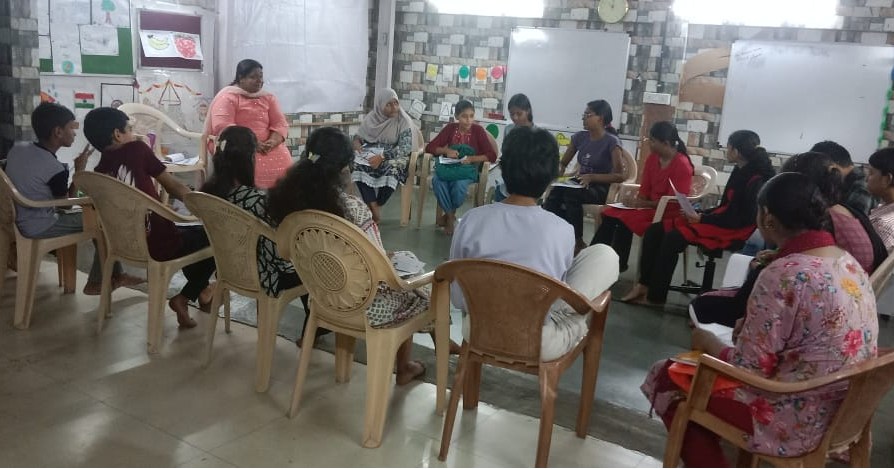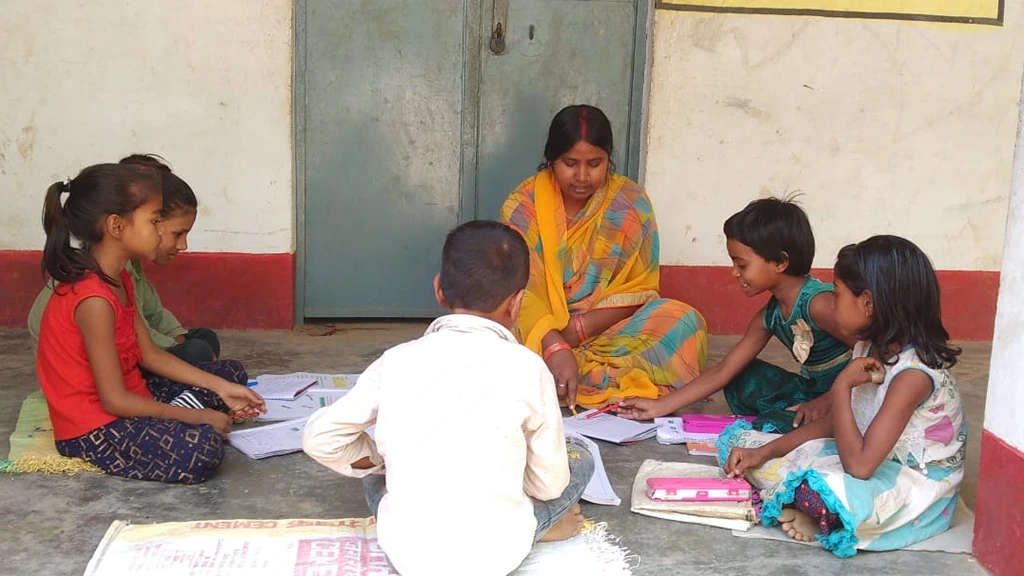Sahyog’s experience of engaging adolescent girls with life-skills: the challenges of adapting to a changing society
Life-skills remain an important component of education for girls. In this piece, the author reflects on 20 years of experiences of engaging girls with life-skills against the backdrop of a changing educational environment and social context. From a phase when girls struggled to stay in school after reaching puberty to the present where there is access to education but not real opportunities for growth, the concerns, modes of communication and responses of the girls have changed.

The origin of Sahyog was in a non-formal education program for out-of-school girls in a sprawling slum settlement in suburban Mumbai. This program, Sahyog-School Without Walls, catered to girls who had dropped out at the primary or middle school levels. The measurable goal was to enable the girls to join the mainstream by appearing for the National Open School Secondary Examination.
Learning to be free
However, not all girls were able to achieve this goal. Some girls who had never been to school joined us when they were sixteen. Other girls had to drop out because of family responsibilities. Some even got married before they finished schooling. However, for all the girls, the ideological goal was to expand freedom, give them a sense of self and build a critical perspective on life and the world around them. So, the skills that they learnt at school helped them to confront opposition and negotiate for more space both within the family and in the community.
After 10 years, when the program lost its relevance with most of the girls being able to continue their school after puberty, we shut down the school. We then attempted to continue working toward the ideological goal through our life-skills program and scholarship/mentorship program for girls who had completed their schooling.
Persistent challenges in building solidarity
What we realized is that despite the increasing access to education and greater opportunities, girls continued to struggle to legitimize their aspirations in the family and at school. Insidious barriers in the form of unsafe neighborhoods and harassment still persisted. While some of the cultural and social barriers had weakened, external challenges in terms of the poor quality of education and high costs, particularly of professional education, hampered their progress.
When we observed girls’ strategies to cope with these challenges, we realized that, while much had been gained, something had also been lost. The girls in our ‘school’ had a critical understanding that enabled them to analyze situations more effectively. This understanding was the bedrock on which solidarity was built, and they recognized the importance of standing together.
Moreover, the school’s pedagogy, which was built around community work, gave them a greater understanding of community dynamics and built empathy. They felt much more equipped to confront and change their life circumstances in the very homes and neighborhoods where they lived.
In contrast, the next generation of girls who were passing out of school were much more individualistic. The compulsion to compete, which is institutionalized in school, made it difficult to build solidarity among them. Similarly, they sought solutions to their problems in tangible interventions such as tutoring inputs, financial aid, technical skills and English-language skills.
These skills are important. However, these could not replace the life-skills that the particular pedagogy of Sahyog had nurtured. This involved the ability to think independently, to recognize who they are as persons and to be able to express their views without fear. Moreover, the live connection that the earlier generation of girls had built with the community was also missing. They could not identify with the problems of the people around them.
The critical importance of life skills
Much has been written about the skills gap and the opportunity gap that disadvantaged youth face in India today. However, there is less focus on the near-absence of life-skills among them. In our experience, the opportunity to learn life-skills had enabled girls who had virtually no education or marketable skills to make empowered economic and personal choices.
For these girls, clarity regarding life goals, a strong sense of self and an ability to understand structural inequality and call out injustice were the keys in shaping a proactive response. This was the case even in very personal/individual decisions, whether it was walking out of a bad marriage, standing up to sexist colleagues or taking up jobs and training opportunities that required them to defy social expectations and norms.
The need to find new narratives
While we could analyze the problem, dealing with it was very challenging. Practical problems of time availability and competing pressures of exams and studies do not allow us enough time to engage with girls in the post-school phase. We also struggle to find new narratives to engage with this generation of girls who are exposed to the internet, which makes everything look familiar and, at the same time, makes everything banal.
In the early 2000s, our girls were inspired by the rich culture of impromptu singing of feminist songs, without thought to talent and performance. Today, girls cannot take a selfie without applying a filter. Making interventions attractive to the current generation needs a lot of effort. Volunteering and sensitization sessions are crucial in their effects on the affective and ideological level. However, we have realized that there are certain strategies which work in this new environment better than others.
Strategies that work
First, having mentors and role-models who are closer to their age and can engage with them in their own terms plays an important role. This facilitates the integration of technological tools that are now much more easily available and accessible. There is also a new language that technology, especially the internet, has spawned, which the younger mentors utilize better.
Ironically, we have found that ‘retro’ activities like story-telling sessions and read-alouds also have great appeal, if executed well. Girls are better able to appreciate art and aesthetics in the less ‘engineered’ experiences of book-reading and oral history.
In conclusion
Connecting structural inequality to their immediate problems works better than the typical lecture on gender inequality. Their issues range from the partiality shown to sons, to restrictions on girls’ dressing choices, to love/romantic relationships which get suffocating.
One area where we have not succeeded as much is in creating solidarity. Befriending and unfriending are now almost banal acts, executed by the click of a mouse. The depth of emotional and physical support through friendships with peers, and also with older women, is missing. We hope to find strategies to rebuild these bonds as well.




No approved comments yet. Be the first to comment!